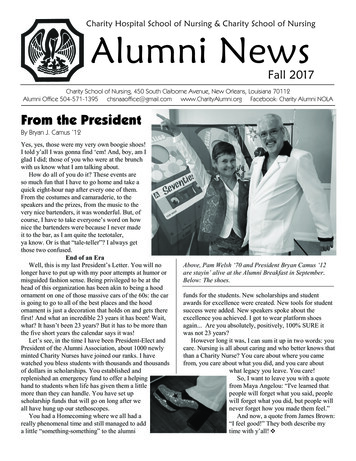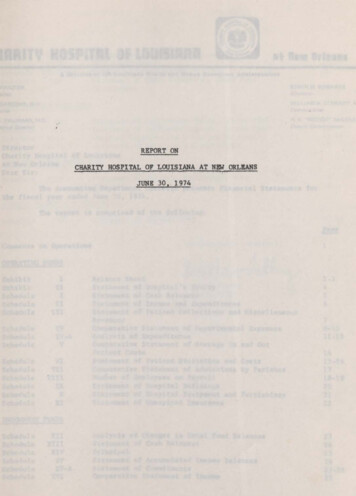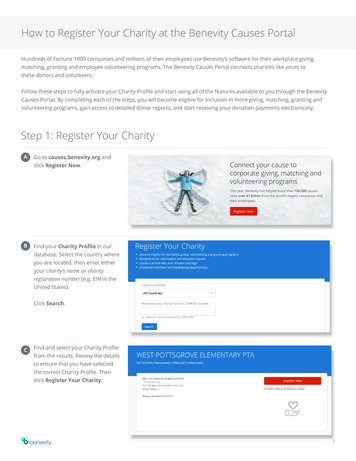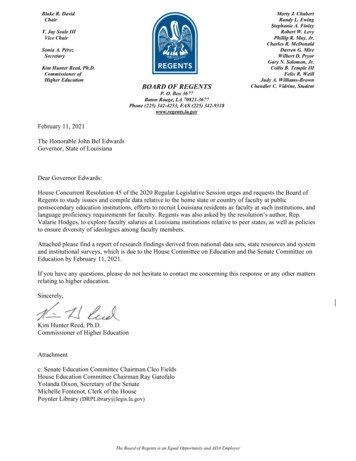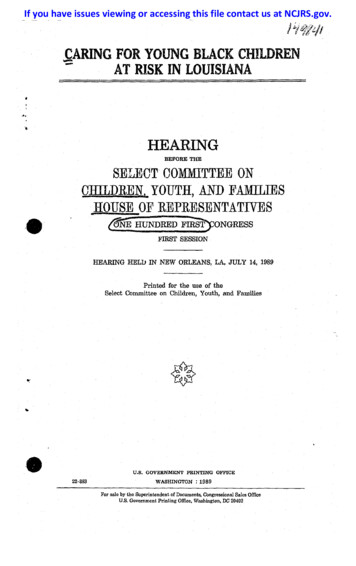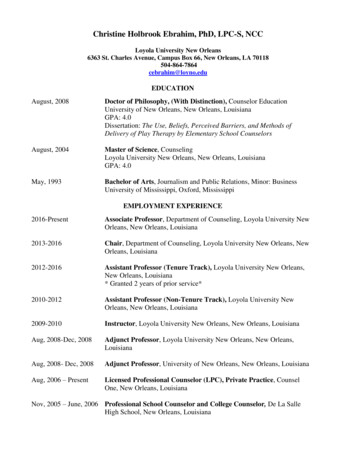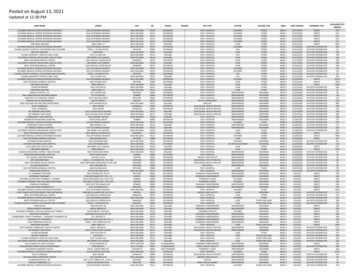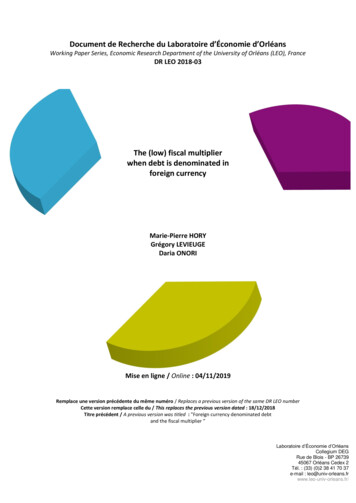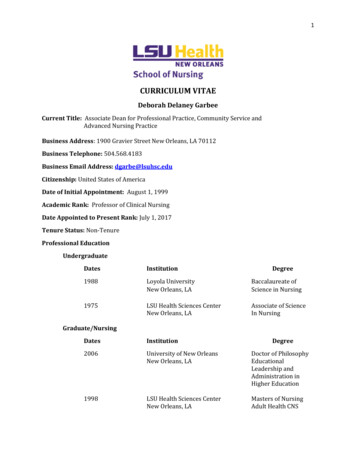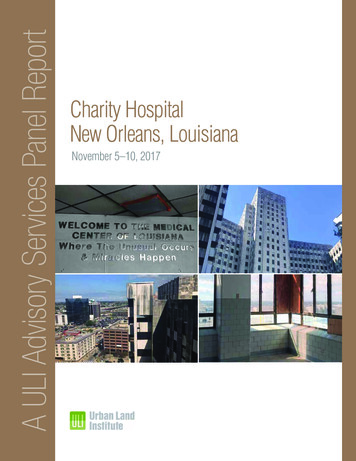
Transcription
A ULI Advisory Services Panel ReportCharity HospitalNew Orleans, LouisianaNovember 5–10, 2017
A ULI Advisory Services Panel ReportCharity HospitalNew Orleans, LouisianaDevelopment Scenarios for Reuse and Revitalizationof Charity HospitalNovember 5–10, 2017
About the Urban Land InstituteTHE URBAN LAND INSTITUTE is a global, memberdriven organization comprising more than 40,000 realestate and urban development professionals dedicated toadvancing the Institute’s mission of providing leadershipin the responsible use of land and creating and sustainingthriving communities worldwide.ULI’s interdisciplinary membership represents all aspectsof the industry, including developers, property owners,investors, architects, urban planners, public officials, realestate brokers, appraisers, attorneys, engineers, financiers, and academics. Established in 1936, the Institutehas a presence in the Americas, Europe, and Asia Pacificregions, with members in 80 countries.The extraordinary impact that ULI makes on land use decision making is based on its members sharing expertise ona variety of factors affecting the built environment, including urbanization, demographic and population changes,new economic drivers, technology advancements, andenvironmental concerns.Peer-to-peer learning is achieved through the knowledgeshared by members at thousands of convenings eachyear that reinforce ULI’s position as a global authority onland use and real estate. In 2017 alone, more than 1,900events were held in 290 cities around the world.Drawing on the work of its members, the Institute recognizes and shares best practices in urban design and development for the benefit of communities around the globe.More information is available at uli.org. Follow ULI onTwitter, Facebook, LinkedIn, and Instagram.Cover photos: Paul Angelone/ULI 2018 by the Urban Land Institute2001 L Street, NWSuite 200Washington, DC 20036-4948All rights reserved. Reproduction or use of the whole or anypart of the contents without written permission of the copyright holder is prohibited.2A ULI Advisory Services Panel Report
About ULI Advisory Servicesgram is to bring the finest expertise in the real estate fieldto bear on complex land use planning and developmentprojects, programs, and policies. Since 1947, this programhas assembled well over 600 ULI-member teams to helpsponsors find creative, practical solutions for issues suchas downtown redevelopment, land management strategies, evaluation of development potential, growth management, community revitalization, brownfield redevelopment,military base reuse, provision of low-cost and affordablehousing, and asset management strategies, among othermatters. A wide variety of public, private, and nonprofit organizations have contracted for ULI’s advisory services.Each panel team is composed of highly qualified professionals who volunteer their time to ULI. They are chosen for theirknowledge of the panel topic and screened to ensure theirobjectivity. ULI’s interdisciplinary panel teams provide a holistic look at development problems. A respected ULI memberwho has previous panel experience chairs each panel.The agenda for a five-day panel assignment is intensive.It includes an in-depth briefing day composed of a tour ofthe site and meetings with sponsor representatives, a dayof hour-long interviews of typically 50 to 75 key community representatives, and two days of formulating recommendations. Long nights of discussion precede the panel’sconclusions. On the final day on site, the panel makes anoral presentation of its findings and conclusions to thesponsor. A written report is prepared and published.Because the sponsoring entities are responsible forsignificant preparation before the panel’s visit, includingsending extensive briefing materials to each member andarranging for the panel to meet with key local communitymembers and stakeholders in the project under consideration, participants in ULI’s five-day panel assignments areable to make accurate assessments of a sponsor’s issuesJERRY JONESTHE GOAL OF THE ULI ADVISORY SERVICES pro-and to provide recommendations in a compressed amountof time.The ULI panel team.A major strength of the program is ULI’s unique ability to drawon the knowledge and expertise of its members, including landdevelopers and owners, public officials, academics, representatives of financial institutions, and others. In fulfillment of themission of the Urban Land Institute, this Advisory Services panelreport is intended to provide objective advice that will promotethe responsible use of land to enhance the environment.ULI Program StaffThomas W. EitlerSenior Vice President, Advisory ServicesBeth SilvermanVice President, Advisory ServicesPaul AngeloneDirector, Advisory ServicesCali SlepinAssociate, Advisory ServicesDaniel LoboSenior Director, Awards and PublicationsJames A. MulliganSenior EditorLaura Glassman, Publications Professionals LLCManuscript EditorBetsy Van BuskirkCreative DirectorDeanna Pineda, Muse Advertising DesignGraphic DesignerCraig ChapmanSenior Director, Publishing OperationsCharity Hospital, New Orleans, Louisiana, November 5–10, 20173
AcknowledgmentsON BEHALF OF THE URBAN LAND INSTITUTE , thepanel would like to thank its sponsors, the LSU Real Estateand Facilities Foundation and LSU Health, for inviting thepanel to examine Charity Hospital and the surrounding district. The panel would also like to thank the Downtown Development District and the community at large for being sowarm and welcoming.Special appreciation goes to Jimmy Maurin, Katye Fayard,Jerry Jones, and Dr. Larry Hollier for providing the panelbriefing materials and helping set up and coordinate interviews. In addition, thank you Leigh Ferguson and StephenFarnesworth for helping represent ULI Louisiana and4providing the panel with context of the New Orleans market. Another big thank you to the ULI Louisiana volunteerswho helped in a variety of capacities throughout the week:Patrick Carey, Luke Elser, Kendra Home, Laura Woltanski,and McDaniel Wyatt.Finally, the panel would like to thank the approximately75 residents, business, faith, and community leaders andrepresentatives from New Orleans and the surroundingparishes who shared their perspectives and insightsduring the panel’s stakeholder interviews.A ULI Advisory Services Panel Report
ContentsULI Panel and Project Staff.6Background and Key Recommendations.7Preamble and Guiding Principles.11Process and Leadership.17Building Uses and District Links.23Project Development Finance.29Conclusion: It’s Time.36Appendix: Redevelopment Cost Estimates.37About the Panel.39Charity Hospital, New Orleans, Louisiana, November 5–10, 20175
ULI Panel and Project StaffPanel ChairJohn WalshCEO, Founder, and PresidentTIGDallas, TexasPanel Vice ChairCarlton BrownComanaging DirectorDirect Investment DevelopmentNew York, New YorkPanel MembersNorman DongManaging DirectorFD Stonewater LLCWashington, D.C.Brandon HillFounder and PresidentFusion Advisory ServicesBirmingham, AlabamaEric MaribojocExecutive Director, Center for Real Estate EntrepreneurshipGeorge Mason UniversityArlington, VirginiaLiz OgbuFounder and PrincipalStudio OOakland, CaliforniaTyrone RachalPresidentUrban Key Capital PartnersAtlanta, GeorgiaLynn RossFounderSpirit of Change Consulting LLCMiami, FloridaMelani SmithAdjunct Faculty, Sol Price School of Public PolicyUniversity of Southern CaliforniaLos Angeles, CaliforniaULI Project StaffPaul AngeloneDirector, Advisory ServicesGrace HillSenior Associate, Meetings and EventsCali SlepinAssociate, Advisory ServicesTom MurphySenior FellowUrban Land InstitutePittsburgh, Pennsylvania/Washington, D.C.6A ULI Advisory Services Panel Report
Background and Key RecommendationsNEW ORLEANS IS RENOWNED for being a city of art,culture, food, and, since 2005, survival and rebirth. According to GNO Inc., the largest industries in the city ofNew Orleans are hospitality, health care, energy, andtrade, with large growth in digital media, biosciences, andenvironmental management. Citywide, New Orleans hasan estimated employment of 558,110 people with an average income of 43,406.New Orleans continues to make a big push for new companies to come to the city, with a focus on entrepreneursas well as a new emphasis on attracting tech companiesand medical research. In fact, immediately following thepanel’s completion, DXC Technology announced that it willopen an office in New Orleans adjacent to the medical district, bringing 2,000 new jobs and leasing up to 300,000square feet—the biggest single economic developmentannouncement in the history of New Orleans.The central business district (CBD) is home to most of thecity’s financial institutions, the Mercedes-Benz Superdomeand the Smoothie King Center, the Ernest N. Morial Convention Center, and City Hall. Tourism affects the wholecity, and attractions are spread throughout New Orleans.In 2016, an estimated 10.4 million tourist visitors spent 7.4 billion—a record amount.The New Orleans area regional population has increasedbetween 2010 and 2016 by 6 percent, putting the regionat a population of 1,268,883, compared with its preKatrina population of 1,337,726. Neither the white northe African American population has climbed back to itspre-Katrina numbers, though they both continue to grow.The Hispanic population has seen a rise of about 7,000people. Within the city of New Orleans, the populationhas contracted from 455,188 to 391,495. The city’s peakpopulation in the 1970s was over 625,000.New Orleans Population Changes20002016African 929Hispanic (any race)Sources: Data Center analysis of U.S. Census Bureau data from 2000census and population estimates for 2016.The percentage of households with children under theage of 18 has dropped from 30 percent in 2000 to 20percent in 2015. This change has pushed the average ageup by almost three years to 37.6 according to Data Centerresearch. Single-person households increased from 33percent in 2000 to 45 percent in 2015.The median household income has increased modestlyfrom 38,601 in 1999 to 39,077 in 2015, based oninflation-adjusted dollars. Although the median income is 10,000 to 15,000 lower than that of the United States,according to Data Center research, New Orleans’s averageincome has increased while the U.S. median income hasdecreased by almost 4,000. According to a BrookingsInstitution study, at 17.7, New Orleans has the secondhighest inequality ratio in the United States between theSingle-Person HouseholdsPercentage of total20002015Orleans Parish33%45%Jefferson Parish27%31%St. Tammany Parish20%24%Metro area27%33%United States26%28%Source: Data Center analysis of U.S. Census Bureau data from Census2000 SF3 and American Community Survey 2015.Charity Hospital, New Orleans, Louisiana, November 5–10, 20177
Inequality Ratio, New Orleans versus Other Major U.S. Cities2014 household incomeCityBottom 95th percentileTop 20th percentileInequality ratioBoston 14,942 266,22417.8New Orleans 11,466 4164,41015.7Providence12,795196,69115.4New Haven12,293187,98415.3Washington, DC21,230320,67915.1Miami12,262184,24215.0San Francisco26,366383,20214.5New York City17,691249,60914.1Sources: Brookings Institution; U.S. Census; ULI.household earning incomes in the bottom 95th percentile( 11,466) and those earning incomes in the top 20thpercentile ( 203,383). This ratio is slightly lower than thatof Boston (17.8), and slightly higher than that of Atlanta(17.5).New Orleans continues to rebuild after Hurricane Katrina.That rebuilding effort includes making great strides increating a more resilient, healthier, and safer city, whilechallenges continue with renovating and repurposingabandoned parcels and buildings throughout the city.The Panel’s AssignmentThe Real Estate and Facilities Foundation (REFF) of Louisiana State University (LSU) asked the panel to study theformer Charity Hospital building to find an adaptive use forthe iconic structure. REFF asked the panel to incorporatethe reuse as a potential critical element in the continuedgrowth and development of downtown New Orleans andthe adjacent BioDistrict. The panel was given two primaryquestions to consider:81. What is the highest and best use of the Charity Hospitalbuilding?2. How can REFF and LSU Health Sciences Center realizethe maximum benefit of outsourcing the redevelopmentof Charity Hospital to a private developer? Maximizingbenefit means finding a use that would work in synergywith the BioDistrict and the LSU Health Sciences Center,a use that would accelerate after development in theBioDistrict, and a use that would be of financial benefitto the REFF.Charity Hospital has 20 floors, including a basement. Thebuilding is zoned for multiple uses and is designated as ahistorically significant building. In May 2017, ZimmerEschette Service II LLC won a bid to conduct a 6.38million cleanup of the building, clearing it of debris, equipment, and furniture, according to the Times-Picayune. Thebuilding has not yet been cleaned of mold or peeling leadpaint and has cosmetic and structural issues. Althoughmajor work needs to be done to put the building intooperation, the 2017 cleanup represented a significantstep in preserving the structure and making the buildingA ULI Advisory Services Panel Report
aTonti§ lvezMercedes ouExE500erettotherKingCharity Hospital and thesurrounding l D1,000FeetKey RecommendationsThe redevelopment of Charity Hospital represents a oncein-a-generation opportunity to catalyze this neighborhoodinto a vibrant social and economic contributor to all ofNew Orleans. In addition, successful redevelopment mayestablish a “New Orleans global example” of ethical andinclusive revitalization. The panel made the following keyrecommendations: TheCharity Hospital Building must remain in place.This is the baseline to all of the panel’s recommendations. Immediate actions should be taken to stabilize thestructural integrity of the building to ensure it does notfurther degrade before reuse.Charity Hospital, New Orleans, Louisiana, November 5–10, 2017EtrndyitlicFe.ASt0ntcherLudearth of other property uses and types in the area and itsadjacencies.²EraFrWillowneGNOBEDD DistrictrtinliaClioRobert sonhiMaTharapseJoVA Hospital BoundaryxReLeRgnoliagMainMajor Facilities Near CharityUniversity Hospital ercedes-BenzSuperdomeliaSaETLaTREREGIONAL PLANNING COMMISSION.nyLOYOLA eHowExititEarcJaThe Charity Hospital building is also inside the bordersof the BioDistrict. The BioDistrict overlaps portions ofthe CBD, Mid-City, and Gert Town neighborhoods. TheBioDistrict comprises mostly medical buildings, including the Veterans Affairs (VA) Hospital, University MedicalCenter, Tulane Hospital and Medical School, LSU MedicalSchool, LSU Health offices, various other medical buildings, and empty buildings including the Charity Hospital.The district is 1,500 acres in a roughly 15-by-five-blockarea. Along with the CBD, the BioDistrict lacks successful street activation, likely as a result of the concentrationof one industry, the commuter lifestyle of the area, and aOnraitasetExOnrampI-10 EetteHCStreeaybiedomLafDeramSuperdI- 10WNORTrtGalvezt1sSurrounding the Charity Hospital building are the CBDand the BioDistrict. Downtown New Orleans is experiencing a significant amount of development, with 6 billionworth of projects either currently under construction or inthe development pipeline. Although the CBD is growingand vacancy rates continue to drop, many buildings arestill vacant or unoccupied. Despite the CBD’s proximity todesirable locations such as the French Quarter and theSuperdome, the area has yet to grow into a destination forpeople before or after work hours. The nearby WarehouseDistrict has succeeded in increasing its after-work appealwith new desirable residences, an emerging art scene, andmany trendy restaurants.itRamphaPrVAHospitalUnnEarExp ExPontchs lopment safer, while taking first steps to prepare thebuilding for redevelopment.BertrandOnra mJohnsonI- 10WLocated near Interstate 10, the Charity Hospital buildingis readily accessible by automobile. In 2015, New Orleanswas demonstrated to be an automobile-dependent community, with 37.5 percent of New Orleans householdsowning two cars, followed by 35.9 percent owning one,10.6 percent owning three, and 10.2 percent owning none,according to Data USA. The Canal Streetcar operated byNew Orleans Regional Transit Authority (RTA) stops a fewblocks from the hospital, and future planned expansionsof the streetcar system will increase the breadth of serviceto the area. Several bus lines run adjacent to the buildingwith a bus stop located at the corner of Tulane Avenue andSouth Villere Street.1an10I-JulLouisianCancer Rese9
Thepanel recognizes that to create a sustainablepathway to shared prosperity, all stakeholders needto work together in new and innovative ways. Thepanel has established concurrent processes for receiving requests for qualifications (RFQs) and requests forproposals (RFPs) for the reuse of Charity Hospital and theestablishment of an economic development district (EDD)to leverage tax increment financing (TIF). Both processesshould be transparent and identify when public commentis accepted and when it is not. Anyreuse of Charity Hospital and revitalization ofthe surrounding neighborhood should ensure thatthe panel’s guiding principles are executed. Theseprinciples include1. Incorporating the “spirit of Charity”;2. Implementing a clear and transparent process;3. Ensuring inclusive and equitable processes andoutcomes;4. Ensuring that reuse and revitalization encompassfinancial feasibility and stewardship;105. Maintaining flexibility as a tenet of good planning;6. Including a public use and community benefit component in reuse of Charity Hospital;7. Improving connectivity;8. Establishing partnership and collaboration;9. Ensuring high-quality design and construction; and10. Translating vision into a strategic plan. Amulti-stakeholder coordinating committee (CharityDistrict Coordinating Committee, or CDCC) should beestablished to facilitate the revitalization goals of theSpirit of Charity Innovation and Economic Development District and develop a strategic plan. TheCDCC would develop and oversee the implementation ofadministrative procedures for the district and ensure thatthe activities and initiatives of each of the bio, research,medical, teaching, and innovation/tech stakeholders arecoordinated, energy is put toward common aims, andresources (whether physical or other) are shared wherefeasible.A ULI Advisory Services Panel Report
Preamble and Guiding PrinciplesTHE ULI ADVISORY SERVICES PANEL was asked toexamine and provide recommendations about what wasthe highest and best use of the Charity Hospital buildingand how to maximize the benefit of its development. Thepanel recognizes that this project has been a long time incoming. Many people in New Orleans have been eager tosee—and at times, frustrated with the pace of conversation about—the future of Charity Hospital. It is abundantlyclear to the panel, and to virtually all whom the panel engaged and interacted with, that now is the time to act.The panel also recognizes that to talk intentionally andinclusively about that future, this discussion needs to beginfrom the same starting place. To that end, the chart belowprovides a snapshot of events leading up to the ULI panel.What This Is All About“Healing helps us to renew our faith in the process ofbecoming.”—Chani NicholasHealing is integral to the context of Charity Hospital. Panelmembers rarely had a conversation with a stakeholder—be it from LSU, the city of New Orleans, or a communityorganization—where that word was not invoked as partof the memory of Charity. The panel believes that healingis not about being stuck in the past or the present; itis about forward movement. And this project is fundamentally about healing, not just the healing of the bodyand emotional spirit, but also the healing of place, fromdisparate investment to disconnected social ties to decaying physical fabric. The panel believes that healing—asdefined here—is a critical component of addressing Charity Hospital’s future.Both before and after Hurricane Katrina in 2005, mistakesand successes have been part of the process. Somedecisions about development were widely shared; somewere not. Some people have thrived here in this neighborhood and in Greater New Orleans; others are continuingto struggle. None of this is an either/or; all is true. Thisexposition is not to relitigate any of this history, but to acknowledge the reality and to move forward with intention,improved processes, and more inclusive outcomes. Theserecommendations are not just about LSU moving forward;How We Got HereTimeline of events leading upto the ULI panel.1970Pre-Katrina20102017Sisters of Charitytake over the hospitalLouisiana Department ofHealth and Hospitals (DHH)takes control of CharityDecision made tobuild a new hospitalFinal decision maderegarding allocationof FEMA fundingLSU Real Estate FacilitiesFoundation completesinternal cleanup; ULIpanel convenes17301939199720052015Charity Hospitalis foundedSixth Charity Hospitalbuilt on Tulane AvenueDHH transfersCharity Hospitalto the LSU HealthFoundationHurricane Katrinahits; Charity Hospitalevacuated 5 daysafter the stormCompletion of UniversityMedical Center; previousRFP process for CharityHospitalCharity Hospital, New Orleans, Louisiana, November 5–10, 2017LIZ OGBU/ULI1830s11
nor are they about the VA, the city of New Orleans, or anyindividual entity or neighborhood moving forward. They areabout New Orleans as a whole moving forward—together.The ULI panel heard from stakeholders and observedprojects, processes, and initiatives that were stymied bythe silos that exist here. When working in silos, a littlemovement may be possible, but, ultimately, you get stuckin mud. The only way to get unstuck is with a collectivenudge. Building a sustainable pathway to shared prosperitycan be part of the New Orleans story, but only if stakeholders from across the spectrum work together in new andinnovative ways.The panelists all agreed that Charity Hospital is a criticalingredient to this new pathway. To that end, the panel recommends that the Charity Hospital building must remainin place. All the panel’s recommendations are made fromthat baseline.Moving ForwardMore than 12 years have passed since Hurricane Katrinastruck. The availability of additional disaster-related federalmoney is now drying up. New Orleans has made greatstrides during that time in rehabilitating neighborhoodsand reconceiving many of its urban systems. However, thecommunity needs to determine how to complete the pivotfrom a “postdisaster” city to a city that once again competes in the global marketplace. It has become apparentthat the city is emerging as world class in sectors beyondhospitality, but to reach its potential, this ascendancecannot be at the expense of the working poor, peopleof color, or those without ready access to structures ofpower. The redevelopment of Charity Hospital representsa once-in-a-generation opportunity not only to catalyzethis neighborhood but also to establish New Orleans as aglobal example of ethical and inclusive revitalization.The panel believes that this project works best if theambitions for what it involves and what it accomplishesare bigger: that is, not only about inclusivity of people, butalso of place. There was a time when dreaming bigger wasingrained in the spirit of New Orleans. Immediately after12the storm, when surrounded by devastation, dreaming wasone of the few things onto which people could hold. Overtime, reality, politics, money, and trauma have gotten inthe way of transforming a number of those dreams intoreality.The panel recognizes that the city suffers from planningfatigue, but finding a way to capture the value of a projectas significant as and at the scale of the Charity Hospitalredevelopment will succeed only if the mindset for thedevelopment is more expansive and includes the areasurrounding the building. The panel does not accept—norshould any of the stakeholders accept—that projects ofthis nature are doomed to be stuck in a rut of complacencyand inaction. The vision must mean expanding the limits ofwhat is possible. It must mean looking not only at CharityHospital but also at the entire district surrounding theproperty. The fate of one is inextricably tied to the other.To ensure a coupling of the two, the panel recommendsthe creation of a new TIF district—economic developmentdistrict (EDD) in Louisiana terms—surrounding CharityHospital to support the redevelopment and to capture theincreased value of the redevelopment to provide sustainable financial support of the district. For the purposes ofthis report, the newly proposed EDD/TIF district is calledthe Spirit of Charity Innovation and Economic DevelopmentDistrict or, simply, the Charity EDD/TIF District.Dreams do not have to remain fantasy. Dreams canbecome the reality of visions of a better life, a better community, a better city. Dreams are not just a luxury for thosewith power. The panel believes that the dream for Charity,like the plan and outcomes proposed in this report, needsto be expressed as a collective vision of all stakeholders.Often, the most powerful dreams—the ones that have thehighest potential to transform reality—are the ones thatstem from shared visions.The following are some examples of developments andactions in cities that have transformed communities. Amplifyingworkforce development to address economic mobility. To address the economic mobility gapA ULI Advisory Services Panel Report
IbervilleLoyolaClaiborneNCharity EDD/TIF DistrictExisting downtown New Orleansdistricts with the proposedSpirit of Charity Innovation andEconomic Development District,which would be bounded bySouth Claiborne Avenue, IbervilleStreet, Loyola Avenue, andPoydras Street.LIZ OGBU/ULIGalvez ResearchNeighborhoodbetween businesses and job seekers, Charlotte, NorthCarolina, launched a new training program for adultswith multiple barriers to employment called Partnershipfor Inclusive Employment and Career Excellence (ProjectPIECE) in partnership with Goodwill Industries of theSouthern Piedmont and Urban League of the CentralCarolinas. The program includes training for careers inbroadband and fiber optics, residential and commercialconstruction, and highway construction. Creatingnew neighborhood connections withpublic space. Business leaders in Dallas reimagined itsdowntown by creating a new urban park, Klyde WarrenPark, a deck that bridges over the sunken WoodallRodgers Freeway. The freeway was an imposing, riverlikebarrier between downtown and the densifying and rapidlyexpanding Uptown neighborhood. Built with a combination of public and disproportionately large private funds,the five-acre park features a flexible, pedestrian-orienteddesign that arranges a children’s park, reading room,great lawn, restaurant, performance pavilion, fountainplaza, games area, dog park, and botanical gardenaround a sweeping pedestrian promenade. The park hasalso created a new town square that bridges the city’sdowntown cultural district with the burgeoning mixed-useneighborhoods to the north. Capturingvalue by redefining public/private partnership. The redevelopment of Union Station in Denverturned a vacant parcel of land and an underused andsomewhat obsolete old central passenger train stationinto a progressive urban redevelopment that is an exemplary model for cities and transit systems worldwide. Theproject involved a public/private partnership consisting ofprivate developers and various public agencies includingcity, county, state, and federal entities and establishedan innovative 30-year TIF district comprising the entireUnion Station and surrounding 20 acres. The locationhas become a central activity area in what was in recentyears an underused, underperforming neighborhood. Buildingan inclusive city from an equitable foundation. Seattle’s Equitable Development Framework guideshow the city prioritizes its work; shapes its budgets,policies, programs, and investments; and structuresthe implementation of targeted strategies and equitabledevelopment projects by using clear objectives forreduci
Charity Hospital New Orleans, Louisiana Development Scenarios for Reuse and Revitalization of Charity Hospital November 5-10, 2017 A ULI Advisory Services Panel Report. 2 L About the Urban Land Institute THE URBAN LAND INSTITUTE is a global, member-driven organization comprising more than 40,000 real
